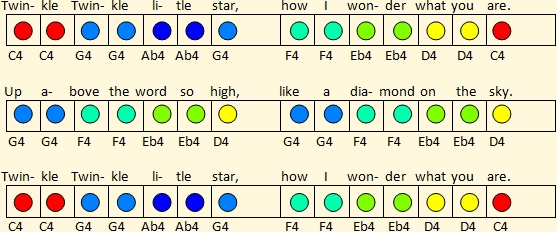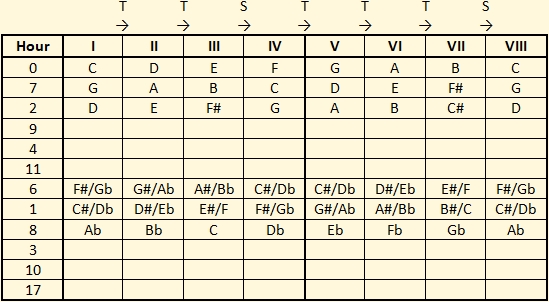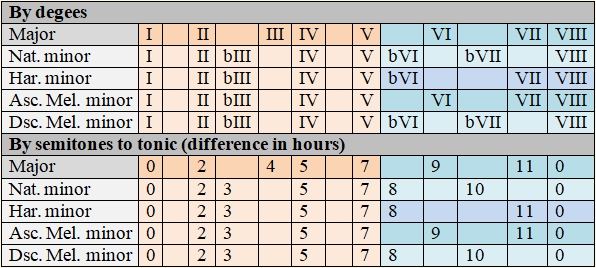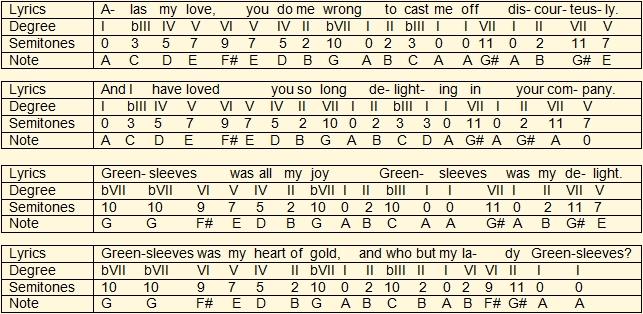
Scales
Content
Major scalesMinor scales
Relative scales
Alterations contained in scales
Key signatures
Harmonic minor scale
Melodic minor scale
Comparison or scales
Deduction of the tonality of a melody
As we mentioned before, a scale is a set of notes arranged according to their frequency. Scales are very important because their notes are the fundamental material for musical creation.
On the page dedicated to musical notes we generate the following equally tempered chromatic scale for C:

This scale contains all the necessary notes for the construction of the scales to consider in this page. The colored notes are those corresponding to the major scale of C on the octave that goes from C4 to C5. In the following the scales on an octave are considered, but without making reference to the octaves considered, and consequently neither to the frequencies.
Major scales
The major scales are the basis upon which much of the theory of music in Western civilization is built. We will use the major C scale as a starting point to generate the major scales for other tonalities and other types of scales. This scale has the following conformation:

According to the previous figure, if a semitone (halftone) advance on the scale is represented by S and the advance of a tone is represented by T, the formula for the creation of major scales is:

This figure introduces the concept of scale degree. Each of the notes on the scale corresponds to a degree of the scale, which are identified by Roman numerals. Each degree of the scale receives its own name that indicates to a certain extent its position and function within the scale; in addition, its Roman numeral indicates the length of the interval of its location with respect to the tonic:
| Degree | Name | Interval from tonic | Function |
|---|---|---|---|
| I | TONIC | Uníson (perfect consonance) | Tonal |
| II | Supertonic | Major second (mild dissonance) | |
| III | MEDIANT | Major third (imperfect consonance) | Modal |
| IV | Subdominant | Perfect fourth (perfect consonance) | Tonal |
| V | DOMINANT | Perfect fifth (perfect consonance) | Tonal |
| VI | Superdominant | Major sixth (imperfect consonance) | Modal |
| VII | Leading tone | Major seventh (strong dissonance) | |
| VIII | OCTAVE | Perfect eighth (perfect consonance) | Tonal |
A scale is the basis on which the tonality, the organization of the notes around the tonic, sits. In this table the names of the most important degrees of the scale have been written in capital letters, which correspond to consonant intervals.
In the study of the intervals we saw that there are consonant and dissonant intervals; the more consonant the interval associated with a degree, the more convenient this degree will be for the creation of harmonies and the greater its importance. As it will be seen later, these will be the first ones selected to conform chords. The major chord formed on the first degree and the major chords formed on the IV and V degrees, dominant and subdominant corresponding to perfect fourth and perfect fifth intervals, will be the most important in the classical harmonization of the tonality corresponding to the tonic.
The degrees of a scale serve a function within the tonality. Degrees with a tonal function are the pillar of tonality, while degrees with a modal function define the mode of tonality; thus, as we shall see later, to obtain a natural minor scale from a major scale, the third and sixth degrees of the major scale are lowered in a semitone, whereby their corresponding intervals become smaller. The resulting minor tonality obtained from this scale is more appropriate for expressing sadness than its major counterpart, more convenient for expressing joy. In both scales the degrees with tonal function remain unchanged.
Another important aspect of the degrees of one scale is that they can present a tendency to lead to other degrees of the scale, to resolve to another degree; for example, upon hearing a sequence of notes in which the latter corresponds to the dominant degree, the ear anticipates (requests) the note corresponding to the tonic degree.
In what follows it is important to know the distribution of the notes of the C major scale on the staff:

Minor scales
The major scale is certainly the most important in Western music, but to develop different musical genres it is necessary to resort to other types of scale. In this section we will consider those that take second place in terms of importance and dissemination: the minor scales.
In the previous table, the function of each of the degrees of the major scale was indicated and it was noted that degrees I, IV, V and VIII have a tonal function and a perfect consonance, while grades III and VI have a modal function and an imperfect consonance. Suppose we want to compose a melody that has the note C as a tonic, but we don't want it to have the sound of the melodies written in the major mode. For this tune to have the note C as a tonal center, we must keep the notes C, F and G, since they correspond to grades I, IV and V and will fulfill the tonal function; to achieve a different sound we will lower a semitone the notes E and A, since they correspond to degrees III and V and have a modal function. To conclude the construction of our new scale we will also lower a semitone the grade B, corresponding to grade VII and thus avoid the strong dissonance that it has with the tonic. Our scale is then in the form:

The scale we have developed is the particular case for the tonic C of the natural minor scale in music theory. Its formula is:

The names of the degrees of this scale and their corresponding functions and consonances are:

In the apart A simple melody of the page Musical notes, you performed the "Twinkle, Twinkle, Little Star" melody on the C major scale. Next we will create an arrangement of this melody in which we will use the C minor scale; that is, we will replace the E4 notes with Eb4 and the A4 notes with Ab4. The result is as follows:

To facilitate the comparison of this version in a minor tone with the original in a major tone, we repeat below the link to the major version; but for a more complete comparison it may be more convenient for you to open a copy of this site in a new tab of your browser and go to the Musical Notes page.
The general opinion is that major scales are better suited to express joy and minor scales to express sadness. This is something very subjective, but you will probably agree that the minor version of "Twinkle, Twinkle, Little Star" has a rather gloomy tone.
The distribution of the notes of the C minor scale on the staff is:

Relative scales
In this section we will study a concept of great importance in music theory: that of relative scales.
If you performed the exercise correctly, you will have obtained the same notes on both scales: C, D, E, F, G, A and B.
The result of the previous exercise leads us to the conclusion that to every major scale there corresponds a natural minor relative scale which is constructed from its degree VI (nine semitones after the tonic; or equivalently, three semitones before the octave tonic) and which has exactly the same notes; and vice versa: to every natural minor scale there corresponds a major relative scale which has exactly the same notes and is constructed from its degree bIII (three semitones after the tonic).
The above result can be displayed on the staff:

The concept of relative scales is of such importance that you should be able to determine almost instantaneously the relative scale of any given scale. A table with pairs of relative scales could have been given here, but the author believes that much better than memorizing such a table is to keep in mind the above: the minor relative tone is three semitones before the tonic and the major relative tone is six semitones after the tonic. Familiarity with the clock analogy makes it possible to instantly visualize the relative tonalities; indeed, let us suppose that we are interested in identifying the minor relative tonality of A major: it is enough to visualize the note A, located at 9 o'clock, and the note F# (3 hours before); the minor relative tonality of the major tonality of A is then the natural minor tonality corresponding to the note F#, located at 6 o'clock.
A very good practical reason for being able to quickly identify relative tonalities is that movement between relative tonalities in a composition is very common in all kinds of musical genres. Another practical, as well as theoretical, reason will be studied below.
Alterations contained in the scales
The only major scale that has no alterations is the scale corresponding to C, and the only minor natural scale that has no alterations is its relative scale, corresponding to La. In order to recognize the tonality in which a melody transcribed in classical notation is found, it is very important that we know the alterations corresponding to each of the scales; therefore, an exercise is proposed below in which you will determine these alterations. The exercise will consist of completing the following table:

The following observations may be useful in carrying out the exercise:
- To help you determine the notes of the scales, the formula of the major scales has been added above the body of the table.
- The first column indicates the location of the tonic on the clock face; this detail can be useful to verify your work. For reasons that will become clear when completing the exercise, progress is made by intervals of fifths; that is, at intervals of seven hours on the face of the watch.
- Two groups of four notes have been identified for each scale, the first starting at the tonic degree (I) and the second at the dominant degree (V). The first group of each scale is exactly the same as the second group of the previous scale. When advancing in the table the sharps are increased by one, which corresponds to the note immediately before the tonic considered (leading note).
- For the major scale of F sharp (G flat) both sharps and flats can be used, which has in equal number: 7.
- For the major scale of C sharp (D flat) we have seven sharps, that is to say that their number was not increased, and six flat, that is to say that their number was reduced by one; therefore, for this scale and for the scales that follow the usual choice is to use flats.
Key signatures
At the beginning of the previous section we pointed out that it was necessary to know the distribution of the alterations of the different scales in order to be able to determine the tonality in which a melody written in standard notation is found. The first symbol that we obtain on the guidelines used in the transcription of a melody is the one corresponding to the cleff, which, in these pages, whose final objective is the teaching of string instruments of the guitar family, will be the G cleff. Next to the cleff is the key signature, the set of symbols of alteration that allows to identify the tonality in which the melody is written. Below are shown the different key signatures, which are obtained from the results of the previous exercise. The order of the key signatures with sharp is obtained by ascending from C by intervals of fifths; that is, traveling in the clockwise direction with seven-hour jumps in the Analogy of the clock. While the order of the key signatures with flats corresponds to those obtained also from the C but descending by intervals of fifths; that is, traveling counterclockwise with seven-hour jumps in the Analogy of the clock:

Observations:
- There are clearly defined patterns for the placement of sharps and flats; it is convenient to memorize them in order to be able to quickly write the key signature of a tonality.
- The C major tonality does not contain accidents, therefore it does not require a signature.
- Key signatures with sharps for other tonalities are written beginning with the sharp placed on the line corresponding to note F# and ending with the numeral placed on the line or space corresponding to the note one tone before the tonic.
- Key signatures with flats are written beginning with the flat placed on the line corresponding to the note Bb and ending with the flat placed on the line or space corresponding to the note an interval of perfect fourth(five semitones) after the tonic.
- To identify the tonalities that correspond to a key signatures made up of sharps, take as a reference the note associated with the last sharp; the tonalities will be the major that is half a tone forward and the relative minor of this major tonality. For example, if the armor is that of three sharps, whose last sharp is C sharp,the tonalities will be D major and its relative minor B flat.
- It is even easier to identify the tonalities corresponding to a signature made up of flats: the tonalities will be the major that has as tonic the note that occupies the penultimate place and its relative minor.For example, the penultimate note of the armor with four flats is Ab, so the tonalities are the Ab major and its relative F minor.
Since the methodology explained for determining the scales associated with an key signature does not distinguish which of the two corresponds to the melody that follows the keysignature, we have to answer this question. The answer is that, depending on the melody, it must be an analysis of the melody to determine the note around which the melody develops; that is, to determine its tonal center. In these pages we will not study how to determine the tonal center of a melody or part of it; however, for simple melodies your ear will be able to distinguish whether it is a melody in major mode or in minor mode, which will answer the question. You already did an exercise in which you noticed the difference between the C major and C minor versions of "Twinkle, Twinkle, Little Star"; however, both scales differ in three notes, and it might not be so easy to discriminate between the version of this melody in C major and its version in its relative A minor, since the scales of both tonalities have the same notes. Let's do an experiment in which, in order to reduce the influence of your familiarity with the previous exercise on its outcome, we will use tonalities other than C major and its relative A minor.
Harmonic minor scale
The natural minor scale has the problem that its seventh degree is a full tone of the octave tonic, so it does not lead to the tonic with the same force as the seventh degree of the major scale; therefore the minor scale is less conclusive than the major scale. Note that this difference is reflected in the different names given to this degrees on both scales: leading tone on the major scale, submediant on the minor scale. The solution given to this problem is to raise a semitone the seventh degree of the natural minor scale to obtain a new scale: the harmonic minor scale, in which the seventh degree is also a leading tone.
Below is the harmonic minor scale for C:

Melodic minor scale
Although the harmonic minor scale solves the problem of resolution towards the tonic, it also has consequences. One of them is that there is now a separation of three semitones between the notes corresponding to degrees VI and VII, which is not convenient from the point of view of the melody, and another is that it affects the harmonization of the scale, such and as we will see on the next page, dedicated to the chords and the harmonization of the scales.
To solve the first difficulty, a third minor scale is used: the melodic minor scale, in which it eliminates the decrease of one semitone of the note corresponding to the sixth degree of the harmonic minor scale, approaching it to only one tone of the note corresponding to the seventh degree. The ascent on the melodic minor scale for C is shown below:

Note that an arrow is shown to indicate ascent across the scale. The reason for emphasizing this fact is that when descending the scale, the note Ab corresponding to the bVI grade is used, which gives a better resolution towards the fifth grade, an extremely important grade. Accordingly, the scale shown in the previous figure corresponds to the ascending melodic minor scale. On the other hand, the descending melodic scale coincides exactly with the natural minor scale executed in descending order.

Comparison of scales
The following table can be very useful for reference purposes and to reinforce what has been learned about scales:

Note that::
- For comparison purposes it is convenient to separate the scales into their five lower notes and their three higher notes.
- The lower five notes of the minor scales are all equal and differ from the lower five notes of the major scale only in the decrease of the third degree by one semitone.
- The higher three notes of the harmonic minor scale differ from the upper three notes of the natural minor scale only in that the note corresponding to the seventh degree is not lowered by one semitone.
- The higher three notes of the melodic minor scale differ from the upper three notes of the harmonic minor scale only in that the note corresponding to the sixth degree is not lowered by one semitone.
- The higher three notes of the melodic minor scale are identical to that of the natural minor scale.
The table highlights these similarities and differences through the use of colors.
Deduction of the tone of a melody
The following is a transcription of a simple arrangement of the melody of "Greensleeves" in the key of A minor.

As the key signature does not contain alterations, we infer that the melody is in C major or in A minor. Its rather sad and complaining tone strongly suggests that it should be in the minor mode. The fact that the first two musical phrases begin in note A and end in note E, interval of fifth (seven hours) is an even stronger indicative; but if we want to know with certainty, and also the type of minor scale used, we must analyze this melody. For this purpose, we elaborate the following table in which the degrees of each one of its notes are identified:

To facilitate the comparison we will proceed to order, without repetitions, the degrees and the intervals used in this melody:

It is clear that this melody uses the melodic minor scale, since it is the only one, in its combination of ascent and descent, that uses degrees bVI, VI, bVII and VII. The other minor scales use only two of these degrees.
NOTE: intervals do not really need to be used, but the fact that Arabic numerals are much simpler than Roman numerals simplifies the comparison.
Various
.